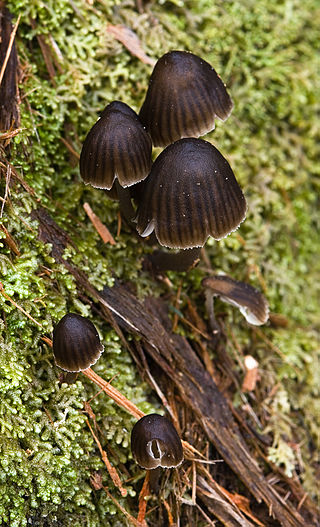
Mycena nargan, commonly known as the Nargan's bonnet, is a species of fungus in the family Mycenaceae, and the sole member of the section Nargan in the genus Mycena. Reported as a new species in 1995, it is known predominantly from Southern Australia. The saprobic fungus produces mushrooms that grow on well-decayed wood, often on the underside of wood lying in litter. The dark chestnut-coloured caps are covered with white, easily removed scales, and reach diameters of up to 2 cm (0.8 in) wide. The pale, slender stems are up to 5 cm (2.0 in) long and have white scales at the base. On the underside of the cap, the cream-coloured gills are widely spaced and bluntly attached to the stem. The edibility of the mushroom is unknown.

Psilocybe aztecorum is a species of psilocybin mushroom in the family Hymenogastraceae. Known from Arizona, Colorado, central Mexico, India and Costa Rica, the fungus grows on decomposing woody debris and is found in mountainous areas at elevations of 2,000 to 4,000 m, typically in meadows or open, grassy conifer forests. The mushrooms have convex to bell-shaped caps 1.5–2 cm (0.6–0.8 in) in diameter, atop slender cylindrical stems that are up to 7.5 cm (3.0 in) long. The color of the caps changes with variations in hydration, ranging from dark chestnut brown to straw yellow or whitish when dry. The base of the stem is densely covered with conspicuous white rhizomorphs, a characteristic uncommon amongst Psilocybe species.
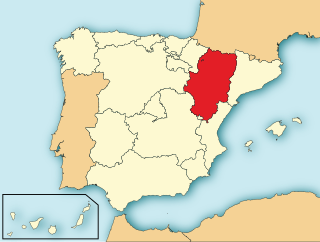
Psilocybe hispanica is a species of fungus in the family Hymenogastraceae. It produces small brown mushrooms with conical to convex caps up to 10 mm (0.4 in) in diameter and stems 16 to 25 mm long by 0.5 to 1 mm thick. Reported as new to science in 2000, it is only known from the Pyrenees mountain range in northern Spain and southwestern France, where it grows on horse dung in grass fields at elevations of 1,700 to 2,300 m. The mushroom contains the psychoactive compound psilocybin. The possible depiction of this species in the 6,000-year-old Selva Pascuala rock art suggests that it might have been used in ancient religious rituals—the oldest evidence of such usage in prehistoric Europe.
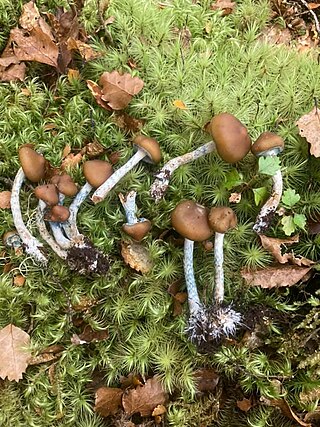
Psilocybe makarorae is a species of psilocybin mushroom in the family Hymenogastraceae. Officially described as new to science in 1995, it is known only from New Zealand, where it grows on rotting wood and twigs of southern beeches. The fruit body (mushroom) has a brownish cap with lighter coloured margins, measuring up to 3.5 cm (1.4 in) wide. The cap shape is either conical, bell-shaped, or flat depending on the age of the mushroom, and it features a prominent umbo. Although the whitish stem does not form a true ring, it retains remnants of the partial veil that covers and protects the gills of young fruit bodies. P. makarorae mushrooms can be distinguished from the similar North American species Psilocybe caerulipes by microscopic characteristics such as the presence of cystidia on the gill faces (pleurocystidia), and cheilocystidia with more elongated necks. Based on the bluing reaction to injury, P. makarorae is presumed to contain the psychedelic compounds psilocybin and psilocin.

Mycena clariviolacea is a mushroom in the family Mycenaceae. First reported as a new species in 2007, it is known only from Kanagawa, Japan, where it fruits on dead fallen twigs in forests dominated by oak and chinquapin trees. Distinctive features of this species are found in its medium-sized, dark violet fruit bodies, with caps up to 25 mm (0.98 in) in diameter and slender stems that are about 30 to 40 mm long. Microscopic characteristics include the amyloid spores, the club-shaped cheilocystidia that are covered with one or more, knob-like, apical protuberances, the absence of pleurocystidia, and the cylindrical, diverticulate caulocystidia.

Mycena fonticola is a species of fungus in the family Mycenaceae. First reported in 2007, it is known only from central Honshu, in Japan, where it grows on dead leaves and twigs in low-elevation forests dominated by oak trees. The fruit body of the fungus has a smooth, violet-brown cap up to 2.5 cm (1.0 in) in diameter, and a slender stem up to 10 cm (3.9 in) long. Distinguishing microscopic characteristics of the mushroom include the relatively large, distinctly amyloid spores, the smooth, spindle-shaped cheilocystidia, the absence of pleurocystidia, the diverticulate hyphae of the cap cuticle, and the absence of clamp connections.

Mycena fuscoaurantiaca is a species of mushroom in the family Mycenaceae. First reported as a new species in 2007, the diminutive mushroom is only found in Kanagawa, Japan, where it grows on dead fallen twigs in lowland forests dominated by hornbeam (Carpinus) and Chinese evergreen oak trees. The mushroom has a brownish-orange conical cap that has grooves extending to the center, and reaches up to 11 mm (0.43 in) in diameter. Its slender stem is colored similarly to the cap, and long—up to 60 mm (2.4 in) tall. Microscopic characteristics include the weakly amyloid spores, the smooth, swollen cheilocystidia and pleurocystidia with long rounded tips, the diverticulate hyphae of the cap cuticle, and the absence of clamp connections.

Mycena intersecta is a species of mushroom in the family Mycenaceae. First reported as a new species in 2007, it is known only from central Honshu, in Japan, where it is found growing solitarily or scattered, on dead leaves in lowland forests dominated by oak. The mushrooms have olive-brown caps up to 12 mm (0.47 in) in diameter atop slender stems that are 50 to 80 mm long by 0.7 to 1.2 mm thick. On the underside of the cap are the distantly spaced, whitish gills that have cross-veins running between them. Microscopic characteristics of the mushroom include the smooth, irregularly cylindrical cheilocystidia, the absence of pleurocystidia, the diverticulate elements of the cap cuticle, the broadly club-shaped to irregularly shaped caulocystidia, the weakly dextrinoid flesh, and the absence of clamp connections. The edibility of the mushroom is unknown.

Mycena lanuginosa is a species of mushroom in the family Mycenaceae. First collected in 2000 and reported as a new species in 2007, it is known only from lowland oak-dominated forests in central Honshu in Japan. The small mushroom is characterized by its grooved, grayish-brown to violet-brown cap up to 11 mm (0.43 in) in diameter, and the slender grayish-brown to reddish-brown stem covered with minute, fine, soft hairs. The mushroom produces amyloid spores. Microscopic distinguishing features include the smooth, spindle-shaped cheilocystidia and pleurocystidia and the diverticulate elements in the outer layer of the cap and the stem.

Mycena multiplicata is a species of mushroom in the family Mycenaceae. First described as a new species in 2007, the mushroom is known only from the prefecture of Kanagawa, Japan, where it grows on dead fallen twigs in lowland forests dominated by oak. The mushroom has a whitish cap that reaches up to 13 mm (0.51 in) in diameter atop a slender stem 15 to 20 mm long and 1 to 1.3 mm thick. On the underside of the cap are whitish, distantly spaced gills that are narrowly attached to the stem. Microscopic characteristics of the mushroom include the amyloid spores, the pear-shaped to broadly club-shaped cheilocystidia which are covered with a few to numerous, unevenly spaced, cylindrical protuberances, the lack of pleurocystidia, and the diverticulate hyphae in the outer layer of the cap and stem. The edibility of the mushroom is unknown.

Mycena mustea is a species of mushroom in the family Mycenaceae. First described as a new species in 2007, the fungus is known only from Kanagawa, Japan, where it grows on dead fallen twigs in lowland forests. The mushroom's dull violet to grayish-violet cap, initially covered with a fine whitish powder, becomes smooth as it matures, and eventually reaches a diameter of up to 10 mm (0.39 in). The stem is slender, up to 90 mm (3.5 in) long, and is covered with stiff white hairs at the base. Underneath the cap are distantly spaced pale brownish gills that are narrowly attached to the stem. Microscopic characteristics of the mushroom include the weakly amyloid spores, the club-shaped cheilocystidia featuring one or more short knob-like protuberances, the absence of pleurocystidia, the diverticulate cap cuticle hyphae, and the absence of clamp connections.

Mycena nidificata is a species of fungus in the family Mycenaceae of the Agaricales. First collected in 2000 and reported as a new species in 2007, it is known only from Kanagawa, Japan, where it grows on the floor of oak forests. The dark brown irregularly wrinkled cap measures up to 25 mm (1.0 in) in diameter. The cap is supported by a thin stem up to 50 mm (2.0 in) long, which is covered at the base by a whitish hairlike growth, and attached to white, cord-like rhizomorphs—aggregations of mycelium that resemble plant roots. The underside of the cap features thin, distantly spaced grayish gills that have distinct veins running between them. At a microscopic level, distinguishing characteristics include the inamyloid spores, the club-shaped cheilocystidia with finger-like appendages, the diverticulate cells in the outer layer of cap and stem, and the presence of clamp connections.

Gymnopilus maritimus is a fungus species of the family Hymenogastraceae first collected in northern Sardinia, Italy, in 2006. The species produces moderately sized, sturdy mushrooms of a reddish-orange colour. The cap, which can measure up to 70 millimetres (3 in) across, is covered in orange fibrils, and sometimes has small scales. The yellowish stem measures up to 110 mm (4 in) in length by 8 mm (0.3 in) in width, and sometimes shows remnants of the partial veil. The mushrooms have thick gills of a variable colour, ranging from yellow to rust but staining darker, and the yellow flesh has a mild taste. The mushrooms leave a rusty-brown spore print, while the spores themselves measure from 7.5–11.5 micrometres (0.00030–0.00045 in) in length. The species is most similar in appearance to G. arenophilus and G. fulgens, but can be differentiated from both morphologically. Despite the similarities, it is not closely related to either, suggesting convergent evolution. Instead, within the genus Gymnopilus, it is most closely related to the spectabilis–imperialis clade. However, it is not particularly similar to any of its closest relatives.

Mycena arcangeliana is a species of Mycenaceae fungus. It has been known by a number of scientific names, and its taxonomy is still somewhat disputed. It produces small mushrooms with caps varying in colour from whitish to a darker grey-brown, and stems of an olive-greyish that fade with age. The mushrooms can be mistaken for the similar Mycena flavescens. They have a mild taste, but a strong smell of iodoform; they are not edible. The species grows on dead wood in autumn months, and can be found throughout Europe.

Xeromphalina setulipes is a species of fungus of the family Mycenaceae. First collected in 2005, it was described and named in 2010 by Fernando Esteve-Raventós and Gabriel Moreno, and is known only from oak forests in Ciudad Real Province, Spain. The species produces mushrooms with dark reddish-brown caps up to 15 millimetres (0.59 in) across, dark purplish-brown stems up to 45 millimetres (1.8 in) in height and distinctive, arched, brown gills. The mushrooms were found growing directly from the acidic soil of the forest floor, surrounded by plant waste, during November.

Marasmius funalis is a species of Marasmiaceae fungus known only from Japan. The species produces small mushrooms with reddish-brown caps up to 6 millimetres (0.24 in) in diameter and dark-brown, threadlike stems of up to 50 millimetres (2.0 in) in length. The species has a number of distinctive microscopic features, including very long cystidia on the stem, visible as bristles. Described in 2002 by Haruki Takahashi, the species grows on dead wood. The closest relative of M. funalis is M. liquidambari, known from Mexico and Papua New Guinea, and it is also similar in appearance to M. hudonii and Setulipes funaliformis, the latter of which was named after M. funalis.
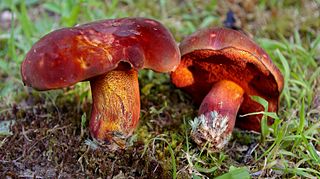
Boletus rubroflammeus is a species of bolete fungus in the family Boletaceae. First described from Michigan in 1971, it is found in the eastern United States and Mexico, where it grows in a mycorrhizal association with hardwood trees. The fruit bodies (mushrooms) of the fungus have caps that are deep red to purplish red, and dark red pores. The stem has coarse, dark red reticulations and a narrow yellow area at the top. All parts of the mushroom quickly stain blue when injured or cut. Lookalikes include Boletus flammans, a lighter-colored species that grows with conifers. Other similar species can be distinguished by differences in distribution, morphology, staining reaction, and microscopic characteristics. Boletus rubroflammeus mushrooms are poisonous, and can cause gastrointestinal distress if consumed.
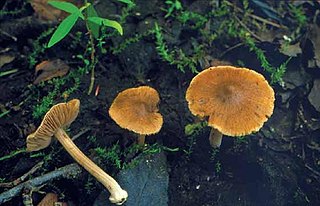
Inocybe saliceticola is a fungus found in moist habitats in the Nordic countries. The species produces brown mushrooms with caps of varying shapes up to 40 millimetres (1.6 in) across, and tall, thin stems up to 62 mm (2.4 in) long. At the base of the stem is a large and well-defined "bulb". The species produces unusually shaped, irregular spores, each with a few thick protrusions. This feature helps differentiate it from other species that would otherwise be similar in appearance and habit.
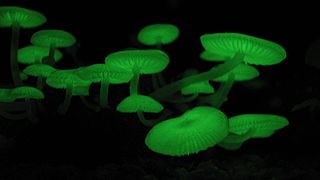
Mycena chlorophos is a species of agaric fungus in the family Mycenaceae. First described in 1860, the fungus is found in subtropical Asia, including India, Japan, Taiwan, Polynesia, Indonesia, and Sri Lanka, in Australia, and Brazil. Fruit bodies (mushrooms) have pale brownish-grey sticky caps up to 30 mm (1.2 in) in diameter atop stems 6–30 mm (0.2–1.2 in) long and up to a millimeter thick. The mushrooms are bioluminescent and emit a pale green light. Fruiting occurs in forests on fallen woody debris such as dead twigs, branches, and logs. The fungus can be made to grow and fruit in laboratory conditions, and the growth conditions affecting bioluminescence have been investigated.
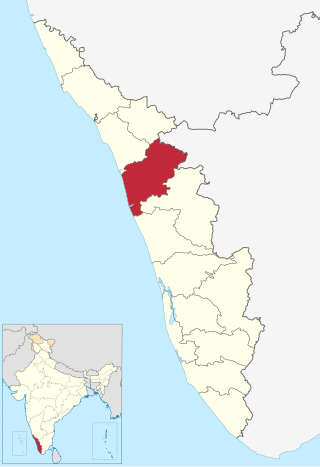
Lepiota harithaka is an agaric mushroom of the genus Lepiota in the order Agaricales. It was described as new to science in 2009. Found in Kerala State, India, fruit bodies of the fungus grow on the ground among bamboo roots.












